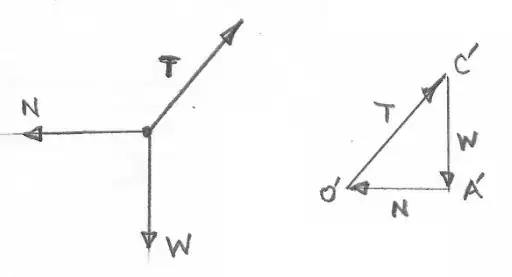Question:
One end of a rope of length $l$ is attached to a vertical wall, the other end being attached to a point on the surface of a uniform sphere of radius $a$. If the weight of the sphere is $W$, then show that the tension of the rope is $T=\frac{W(l+a)}{\sqrt{2al+l^2}}$.
My tutor's attempt:
$$\text{We shift $\vec{W}$ to the line segment CA}\tag{1}$$
Now,
$$OC=OB+BC$$
$$OC=a+l$$
And,
$$OA=a$$
Now,
$$OC^2=OA^2+AC^2$$
$$AC^2=(a+l)^2-a^2$$
$$AC^2=a^2+2al+l^2-a^2$$
$$AC^2=2al+l^2$$
$$AC=\sqrt{2al+l^2}$$
Now, comparing $\vec{N}$, $\vec{T}$ and the shifted $\vec{W}$ with $\triangle AOC$,
$$\frac{N}{a}=\frac{T}{l+a}=\frac{W}{\sqrt{2al+l^2}}$$
$$[\text{If three forces acting at a point are in equilibrium then the sides of any triangle taken in order parallel to the forces will be proportional to the forces}]$$
Using 2nd and 3rd fractions,
$$\frac{T}{l+a}=\frac{W}{\sqrt{2al+l^2}}$$
$$T=\frac{W(l+a)}{\sqrt{2al+l^2}}\ \text{(showed)}$$
My book's attempt:
Using Lami's theorem,
$$\frac{T}{\sin(90^{\circ})}=\frac{W}{\sin(180^{\circ}-\angle COA)}$$
$$T=\frac{W}{\sin(\angle COA)}$$
$$T=\frac{W}{\frac{CA}{CO}}$$
$$T=\frac{W}{\frac{\sqrt{2al+l^2}}{a+l}}$$
$$T=\frac{W(l+a)}{\sqrt{2al+l^2}}\ \text{(showed)}$$
My comments:
I think my tutor's attempt is wrong (no offense intended to him) and my book's is right, even though both were able to prove the question statement. My tutor in $(1)$ shifted $\vec{W}$ to $CA$. How can he do that? Isn't force only a sliding vector or a bound/localized/fixed vector? As my tutor shifted $\vec{W}$, I think my tutor is wrong.
On the contrary, my book did the math easily and accurately in my opinion.
My question:
- Isn't my tutor's attempt wrong as he shifted $\vec{W}$?


